As air travel continues to grow, the importance of well-designed airports cannot be overstated. Have you ever wondered what makes an airport truly efficient and safe? The answer lies in the meticulous planning and execution of aviation infrastructure development.
The Federal Aviation Administration (FAA) plays a pivotal role in setting standards for civil airports, heliports, and seaplane bases. By developing stringent engineering, design, and construction standards, the FAA ensures that airports meet the necessary criteria for safe operations.
Effective runway design is critical to an airport’s overall functionality. It involves more than just building a runway; it’s about creating a safe and efficient pathway for aircraft to take off and land.
Key Takeaways
- The FAA sets standards for airport design and construction.
- Safe and efficient runway design is crucial for airport functionality.
- Aviation infrastructure development is key to modern air travel.
- Stringent engineering standards ensure safe airport operations.
- Well-designed airports are essential for growing air travel demands.
Understanding Runway Engineering
Understanding the principles of runway engineering is essential for the development of efficient and safe airport infrastructure. Airport engineering is a highly specialized field within civil and transportation engineering that focuses on the design, construction, and maintenance of airports.
Definition of Runway Engineering
Runway engineering involves the application of civil engineering principles to ensure that runways are constructed to withstand various environmental conditions and aircraft operations. It encompasses a broad range of activities, including airport runway design, construction, and maintenance.
Effective runway engineering requires a deep understanding of the complex interactions between the runway, aircraft, and environmental factors. For more information on the broader context of transportation network engineering, visit Transportation Network Engineering.
Importance in Airport Operations
The importance of runway engineering in airport operations cannot be overstated. Well-designed and maintained runways are critical for ensuring the safety of passengers and crew, as well as for facilitating efficient aircraft operations. A key aspect of this is the provision of civil engineering services that support the development and upkeep of airport infrastructure.
| Aspect | Description | Importance |
|---|---|---|
| Design | Involves planning and designing runways to meet safety and efficiency standards. | High |
| Construction | Construction of runways using appropriate materials and techniques. | High |
| Maintenance | Regular maintenance to ensure runways remain safe and functional. | Critical |
The Role of Runway Engineers
Ensuring the safety and efficiency of airport operations, runway engineers play a crucial role. Their work encompasses a broad range of activities, from designing runways to ensuring compliance with regulatory standards.
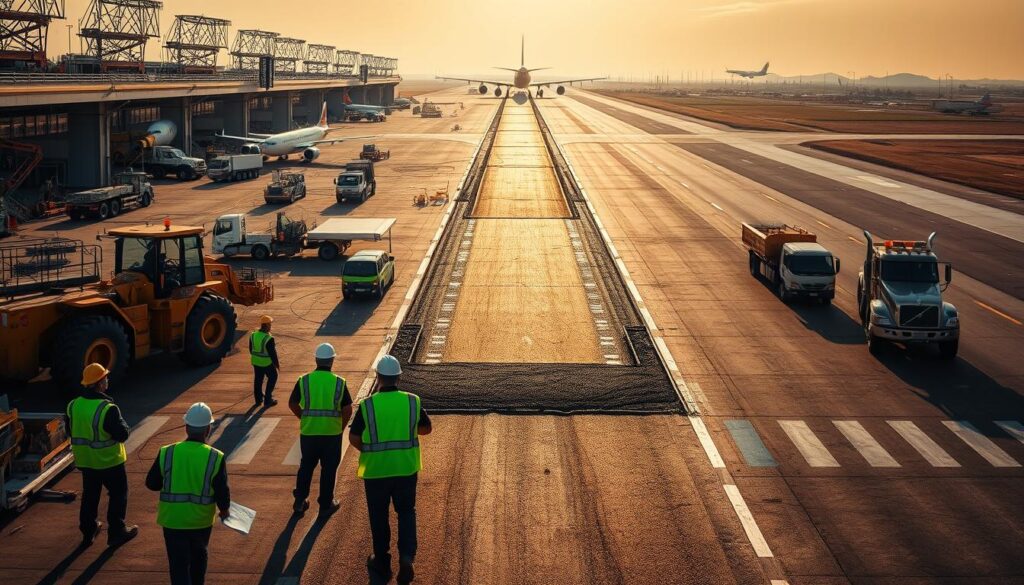
Key Responsibilities
Runway engineers are responsible for the design, construction, and maintenance of runway construction projects. This includes:
- Designing runways, taxiways, and aprons to meet specific aviation standards.
- Overseeing the construction process to ensure it is completed on time and within budget.
- Ensuring compliance with FAA regulations and other relevant standards.
- Conducting regular inspections to identify and address potential safety issues.
Skills and Qualifications Required
To excel as a runway engineer, one must possess a combination of technical knowledge and practical skills. Key qualifications include:
- A degree in civil engineering or a related field, with a focus on aerospace engineering solutions.
- Experience in managing large-scale construction projects.
- Knowledge of FAA regulations and standards for airport construction.
- Strong analytical and problem-solving skills to address complex engineering challenges.
By combining these skills and qualifications, runway engineers can effectively contribute to the development of safe and efficient airport infrastructure.
Types of Runways
Different types of runways are constructed to meet the unique demands of commercial and military aviation. The type of runway and its surface material are critical factors in ensuring safe and efficient aircraft operations.
Commercial vs. Military Runways
Commercial runways are designed for passenger and cargo flights, prioritizing safety and efficiency for a wide range of aircraft sizes. In contrast, military runways have different requirements, often needing to accommodate larger and heavier aircraft, as well as specific military equipment.
For instance, commercial runways at major airports like JFK International Airport in New York are designed to handle high volumes of traffic, with features such as advanced lighting systems and precision approach path indicators (PAPI). On the other hand, military runways, such as those found at Ramstein Air Base in Germany, are built to withstand the stresses of heavy military aircraft and equipment.
Different Surface Materials Used
The surface material of a runway is a crucial aspect of its design, affecting durability, maintenance needs, and aircraft performance. The most common materials used are asphalt and concrete, each with its advantages and disadvantages.
| Material | Advantages | Disadvantages |
|---|---|---|
| Asphalt | Cost-effective, easier to repair | Less durable, requires more frequent maintenance |
| Concrete | More durable, less maintenance over time | Higher initial cost, more challenging to repair |
According to the Federal Aviation Administration guidelines, the choice of surface material depends on various factors, including climate, expected traffic volume, and aircraft types.
Effective runway maintenance is crucial for extending the lifespan of the runway, regardless of the surface material. Regular inspections and timely repairs are essential for ensuring the safety and efficiency of aircraft operations. Additionally, airport runway rehabilitation projects are vital for upgrading existing runways to meet current aviation standards.
Runway Design Principles
The principles guiding runway design are multifaceted, focusing on both safety and operational efficiency. Effective runway design is a critical component of airport runway design, influencing the overall safety and productivity of air traffic.
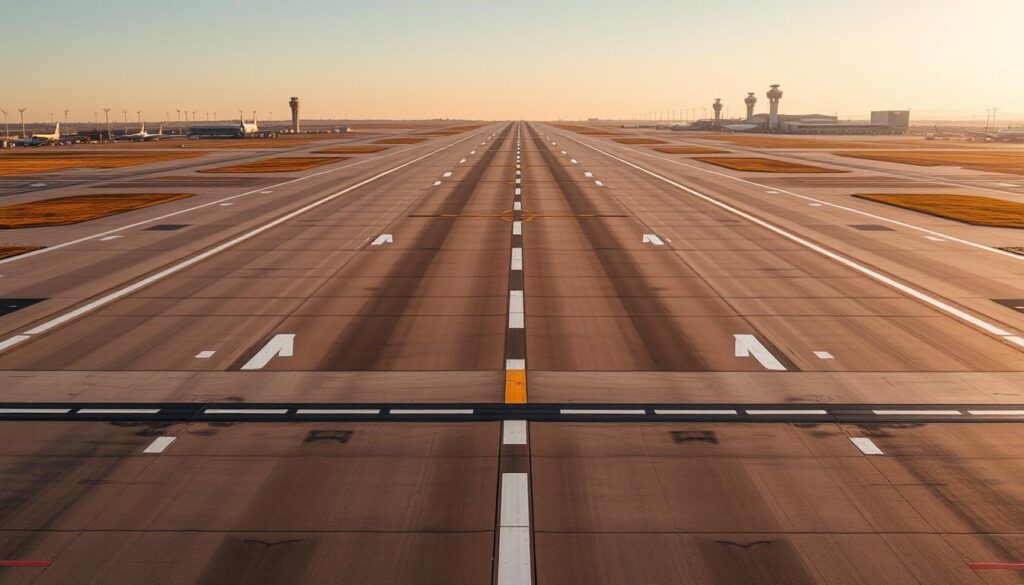
Safety Considerations
Safety is paramount in runway engineering. Designers must consider various factors to ensure safe takeoffs and landings. These include:
- Runway length and width
- Surface material and condition
- Lighting and signage
The surface material of a runway is crucial for safety. Different materials have varying effects on aircraft performance, especially under different weather conditions.
Efficiency in Design
Efficiency in airport runway design is about optimizing the runway’s capacity to handle air traffic while minimizing delays. This involves:
| Design Factor | Influence on Efficiency |
|---|---|
| Runway Orientation | Affects wind resistance and aircraft alignment |
| Runway Length | Determines the maximum aircraft size and weight |
| Surface Material | Influences friction and aircraft braking performance |
By carefully considering these factors, engineers can design runways that are both safe and efficient, meeting the demands of modern air traffic.
Materials Used in Runway Construction
Runway construction requires careful material selection to ensure safety and durability. The choice of material depends on several factors, including climate, aircraft traffic, and maintenance requirements.
Asphalt vs. Concrete
Asphalt and concrete are the two most commonly used materials in runway construction. Asphalt is a popular choice due to its flexibility and cost-effectiveness. It can be laid down quickly, which minimizes the disruption to airport operations. However, it requires more frequent maintenance compared to concrete.
Concrete, on the other hand, offers greater durability and resistance to heavy aircraft traffic. It can withstand the weight and friction generated by large planes, making it a preferred choice for major airports. For more detailed information on the characteristics of different materials, visit airport runway materials.
- Asphalt advantages:
- Flexibility
- Cost-effective
- Quick installation
- Concrete advantages:
- Durability
- Resistance to heavy traffic
- Long lifespan
Innovative Materials and Technology
The use of innovative materials and technology is transforming the field of civil engineering services. New materials such as polymer-modified asphalt and fiber-reinforced concrete are being developed to enhance the performance and sustainability of runways.
Some of the benefits of these innovative materials include:
- Improved durability
- Enhanced safety features
- Reduced environmental impact
As the aviation industry continues to evolve, the incorporation of advanced materials and technologies will play a crucial role in shaping the future of runway construction.
Runway Length and Width Requirements
Aircraft operations rely heavily on the precise dimensions of runways to ensure safe takeoffs and landings. The length and width of runways are critical factors that directly impact the safety and efficiency of aircraft operations.
Factors Influencing Length
The length of a runway is influenced by several factors, including the type of aircraft it serves, the altitude of the airport, and prevailing climate conditions. For instance, aircraft require longer runways at higher altitudes due to the lower air density, which affects engine performance and lift.
Key Factors Affecting Runway Length:
- Aircraft type and size
- Airport altitude
- Climate conditions (temperature, wind)
- Air traffic volume
For example, larger commercial aircraft need longer runways to achieve the necessary speed for takeoff, especially when fully loaded.
Standard Width Specifications
The width of a runway is also subject to specific standards to ensure safe operations. The width requirements vary based on the category of the runway and the type of aircraft it accommodates.
| Runway Category | Minimum Width (meters) | Typical Aircraft |
|---|---|---|
| Precision Approach | 45 | Commercial airliners |
| Non-Precision Approach | 30-45 | Regional jets, turboprops |
| Visual Approach | 18-30 | Smaller commercial, private aircraft |
Runway maintenance is crucial to uphold these standards, ensuring that the runway remains safe and operational. Regular inspections and repairs are necessary to maintain the integrity of the runway surface.
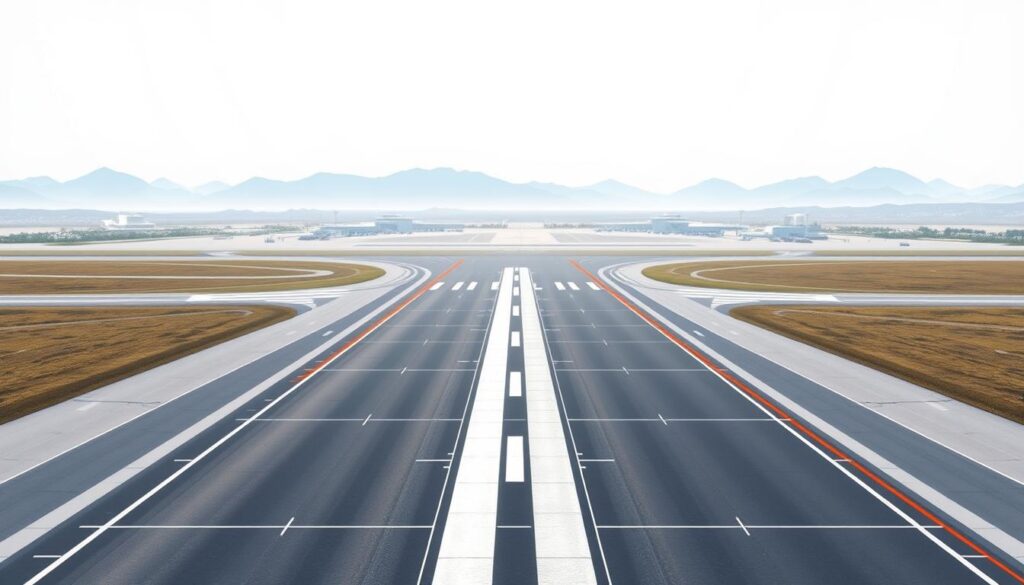
In conclusion, the length and width of runways are determined by a combination of factors, including aircraft type, altitude, and climate. Adhering to standard specifications is essential for aviation infrastructure development and ensuring the safety of aircraft operations.
Runway Drainage Systems
Effective runway drainage systems are crucial for ensuring the safety and operational efficiency of airports. Proper drainage is essential for maintaining safe runway conditions by preventing water accumulation, which can lead to accidents.
Importance of Proper Drainage
The importance of proper drainage cannot be overstated, as it directly impacts the safety of aircraft operations. Aerospace engineering solutions play a significant role in designing and implementing effective drainage systems. These systems are designed to handle intense rainfall and prevent flooding on the runway.
Design Considerations
When designing runway drainage systems, engineers must consider several factors, including rainfall intensity, runway slope, and surface material. Effective drainage design ensures that water is quickly removed from the runway surface, reducing the risk of hydroplaning and improving overall safety.
The following table outlines key design considerations for runway drainage systems:
| Design Factor | Description | Importance |
|---|---|---|
| Rainfall Intensity | The rate at which rainfall is expected to occur. | High |
| Runway Slope | The gradient of the runway surface. | Medium |
| Surface Material | The type of material used for the runway surface. | High |
In conclusion, the design and implementation of effective airport runway rehabilitation projects, including drainage systems, are critical for maintaining safe and operational runways. By considering key design factors and leveraging aerospace engineering solutions, airports can ensure the highest level of safety and efficiency.
Navigating Environmental Concerns
Runway engineering is not just about designing safe and efficient airports; it’s also about minimizing environmental impact. As the aviation industry continues to grow, the need to balance infrastructure development with environmental stewardship becomes increasingly important.
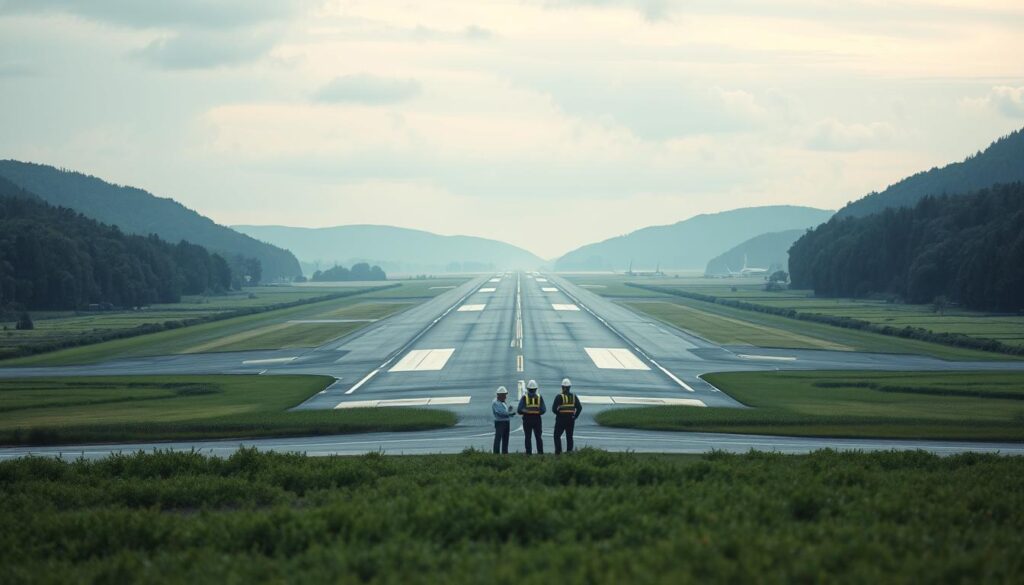
Impact on Local Ecosystems
The construction and operation of runways can have significant effects on local ecosystems. Noise pollution and habitat destruction are two of the most pressing concerns. Airports must comply with environmental regulations to minimize their impact on local wildlife and ecosystems.
According to a study, “the expansion of airport infrastructure can lead to the destruction of natural habitats, affecting biodiversity and ecosystem services.” This highlights the need for careful planning and mitigation strategies in runway engineering projects.
Strategies for Mitigation
To mitigate the environmental impact, runway engineers can employ several strategies. One approach is the use of noise reduction technologies, such as sound barriers and quieter aircraft designs. Another strategy involves implementing environmental management systems to monitor and reduce the overall environmental footprint of airport operations.
- Conducting thorough environmental impact assessments before construction begins.
- Implementing sustainable practices during the construction phase.
- Using technology to reduce noise and emissions.
As
“the aviation industry moves towards more sustainable practices, the role of runway engineering in minimizing environmental impact will become even more critical.”
This shift towards sustainability is not just a regulatory requirement but a necessity for the long-term viability of the aviation industry.
Runway Maintenance Practices
Runway maintenance practices are essential for preventing deterioration and ensuring compliance with aviation standards. Regular maintenance not only enhances safety but also contributes to the overall efficiency of airport operations.
Routine Inspections
Routine inspections are a critical component of runway maintenance. These inspections involve thorough checks for signs of wear and tear, including cracks, potholes, and surface degradation. Advanced technologies such as drones and ground-penetrating radar are increasingly being used to facilitate more accurate and efficient inspections.
The frequency and scope of inspections can vary depending on factors such as traffic volume, weather conditions, and the age of the runway. For instance, runways subjected to heavy traffic or extreme weather conditions may require more frequent inspections.
- Visual inspections to identify surface damage
- Friction testing to assess runway surface grip
- Structural evaluations to detect subsurface issues
Repair Techniques
Once issues are identified during inspections, appropriate repair techniques must be applied to restore the runway to a safe and operational condition. The choice of repair technique depends on the nature and extent of the damage.
Common repair techniques include:
- Sealing cracks to prevent water infiltration
- Resurfacing to restore friction and smoothness
- Reconstruction in cases of severe deterioration
| Repair Technique | Description | Application |
|---|---|---|
| Crack Sealing | Filling cracks with sealant to prevent further damage | Early stages of crack formation |
| Resurfacing | Applying a new surface layer to improve friction and smoothness | Surface wear and tear |
| Reconstruction | Complete overhaul of the runway surface and structure | Severe deterioration or major damage |
Effective runway maintenance practices are vital for ensuring the safety and efficiency of airport operations. By leveraging advanced technologies and techniques, airports can minimize downtime and extend the lifespan of their runways.
Runway Safety Management
Runway safety management is a multifaceted discipline that encompasses various technologies and protocols to enhance airport safety. Effective civil engineering services play a critical role in designing and maintaining safe runways.
Use of Technology in Safety
The use of technology is critical in enhancing runway safety. Advanced surveillance systems and sensors can detect potential hazards and alert authorities in real-time. For instance, runway safety initiatives often incorporate cutting-edge technology to monitor and manage runway conditions.

Emergency Protocols
Emergency protocols are a vital component of runway safety management. These protocols include evacuation plans, emergency response teams, and regular drills to ensure preparedness. Regular runway maintenance is also essential to prevent accidents caused by surface deterioration or other hazards.
Moreover, collaboration between airport authorities, airlines, and regulatory bodies is crucial for developing and implementing effective emergency protocols. By working together, they can ensure a comprehensive approach to runway safety, minimizing the risk of accidents and enhancing overall airport security.
Regulatory Standards in Runway Engineering
Regulatory standards are the backbone of runway engineering, ensuring safety and efficiency in airport operations. These standards are crucial for the design, construction, and maintenance of runways, directly impacting the safety of aviation.
FAA Guidelines
The Federal Aviation Administration (FAA) sets comprehensive guidelines for airport design and construction, including runway engineering. These guidelines cover various aspects such as runway length, width, surface material, and drainage systems. For instance, the FAA specifies that runway surfaces must be constructed to withstand the weight and frequency of aircraft landings and takeoffs.
Key FAA Requirements:
- Runway length and width specifications based on aircraft type
- Surface material standards for durability and safety
- Drainage system requirements to prevent water accumulation
- Lighting and marking standards for visibility
International Standards
In addition to FAA guidelines, international standards play a significant role in runway engineering. These standards are developed by organizations such as the International Civil Aviation Organization (ICAO). ICAO standards ensure consistency in runway design and operation across different countries, facilitating international aviation.
Key aspects of international standards include:
| Aspect | Description | Benefit |
|---|---|---|
| Runway Design | Standards for runway length, width, and surface | Ensures safety and compatibility with international aircraft |
| Drainage Systems | Requirements for effective water drainage | Prevents hydroplaning and ensures safe landings |
| Lighting and Markings | Standards for visibility and navigation | Enhances safety during night and low-visibility conditions |
By adhering to both FAA guidelines and international standards, airports can ensure that their runways are designed and constructed to the highest safety and efficiency standards. This not only enhances aviation safety but also supports the smooth operation of air traffic, both domestically and internationally.
Future Trends in Runway Engineering
Sustainability and technological integration are the twin pillars that will define the future of runway engineering, shaping safer and more efficient airports. As the aviation industry continues to evolve, the need for innovative solutions that address both environmental concerns and operational efficiency becomes increasingly paramount.
Sustainable Practices
The adoption of sustainable practices in runway engineering is gaining momentum, driven by the need to reduce the environmental footprint of airport operations. This includes the use of recycled materials in construction and the implementation of designs that minimize environmental disruption. For instance, the use of porous pavements can significantly reduce stormwater runoff, thereby decreasing the burden on drainage systems.
Moreover, energy-efficient lighting systems are being integrated into runway designs, not only reducing energy consumption but also minimizing light pollution. These sustainable practices not only contribute to a more environmentally friendly airport operation but also enhance the overall safety and efficiency of air travel.
Automation and Technology Integration
The future of runway engineering is also being shaped by the integration of automation and advanced technologies. The use of Artificial Intelligence (AI) and Internet of Things (IoT) devices is revolutionizing airport operations, enabling real-time monitoring and predictive maintenance of runway infrastructure. According to a report on how AI is transforming civil engineering, such technologies are significantly enhancing the resilience and efficiency of airport infrastructure.
Furthermore, automation is streamlining the design and construction processes, reducing the likelihood of human error and improving overall quality. The incorporation of Building Information Modelling (BIM) is a prime example, allowing for more accurate and efficient project planning and execution.

As runway engineering continues to evolve, the synergy between sustainable practices and technological innovation will be crucial in shaping the airports of the future. By embracing these trends, the industry can look forward to safer, more efficient, and environmentally friendly air travel.
Case Studies of Successful Runway Projects
Several high-profile runway projects in the United States have demonstrated excellence in aviation infrastructure development. These projects have not only enhanced the capacity and safety of airports but have also provided valuable lessons for future runway construction endeavors.
Notable Projects in the U.S.
The U.S. is home to several world-class airports that have undergone significant runway construction projects. One such example is the Chicago O’Hare International Airport’s new runway, which has been highlighted for its project excellence and sustainability.
Another notable project is the reconstruction of the runway at LaGuardia Airport in New York, which involved significant upgrades to improve safety and efficiency. According to a report, “The reconstruction project at LaGuardia Airport was a complex endeavor that required meticulous planning and execution”
“The reconstruction of LaGuardia’s runway was a monumental task that showcased the importance of detailed planning and innovative engineering solutions.”
Lessons Learned from Challenges
Despite the successes, runway construction projects often face challenges such as environmental concerns, logistical complexities, and budget constraints. For instance, the construction of a new runway at Seattle-Tacoma International Airport involved addressing environmental concerns through innovative design and mitigation strategies.
| Project | Challenges | Lessons Learned |
|---|---|---|
| Chicago O’Hare International Airport | Sustainability and noise reduction | Innovative materials and design can significantly reduce environmental impact |
| LaGuardia Airport Reconstruction | Logistical complexities and budget constraints | Meticulous planning and phased construction can mitigate logistical challenges |
| Seattle-Tacoma International Airport | Environmental concerns | Innovative design and mitigation strategies can effectively address environmental issues |
These case studies underscore the importance of careful planning, innovative engineering, and sustainability in runway construction projects. By learning from the challenges faced in these projects, engineers and planners can develop more effective strategies for future aviation infrastructure development.
Collaborations in Runway Engineering
Effective runway engineering requires a collaborative approach, involving multiple disciplines and expertise. The complexity of designing and maintaining runways necessitates the integration of various stakeholders to ensure projects are executed efficiently and safely.
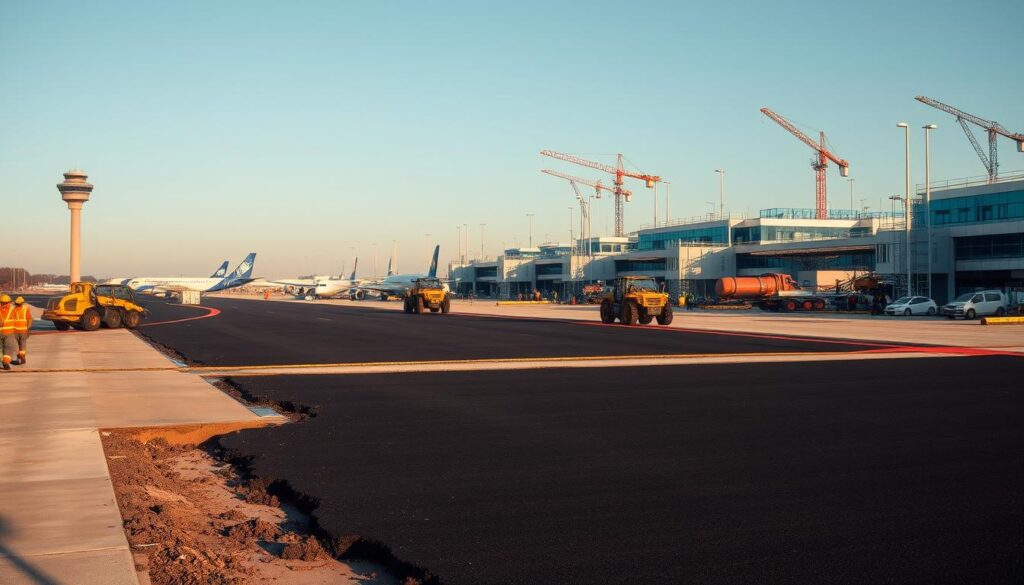
Working with Architects and Planners
Collaboration with architects and planners is crucial in the initial stages of runway engineering projects. These professionals bring valuable insights into the design and functionality of airport infrastructure, ensuring that runways are not only safe but also optimized for operational efficiency. By working together, engineers and architects can develop innovative solutions that meet the needs of modern air travel while adhering to strict safety standards.
The use of advanced civil engineering services is pivotal in this collaborative process, enabling the development of sophisticated runway designs that can withstand various environmental conditions.
Involvement of Government Agencies
Government agencies play a vital role in runway engineering projects, providing regulatory oversight and ensuring compliance with national and international aviation standards. Their involvement is critical in the planning and execution phases, helping to mitigate risks and guarantee that projects meet all necessary safety and operational requirements.
In projects involving airport runway rehabilitation, government agencies work closely with engineers and contractors to ensure that work is carried out efficiently, minimizing disruptions to airport operations.
Conclusion: The Future of Runway Engineering
Runway engineering is a vital component of airport design and operations, playing a critical role in ensuring the safety and efficiency of air travel. As the aviation industry continues to evolve, the future of runway engineering is focused on innovation and sustainability.
Key Developments
The incorporation of aerospace engineering solutions is transforming the field, enabling the development of more efficient and sustainable runways. Effective runway maintenance is also crucial, as it directly impacts the safety and longevity of airport infrastructure.
Innovation in Airports
By embracing advanced technologies and sustainable practices, airports can enhance their operational efficiency while minimizing their environmental footprint. The future of runway engineering will be shaped by the continued adoption of innovative solutions, ultimately benefiting the aviation industry as a whole.
